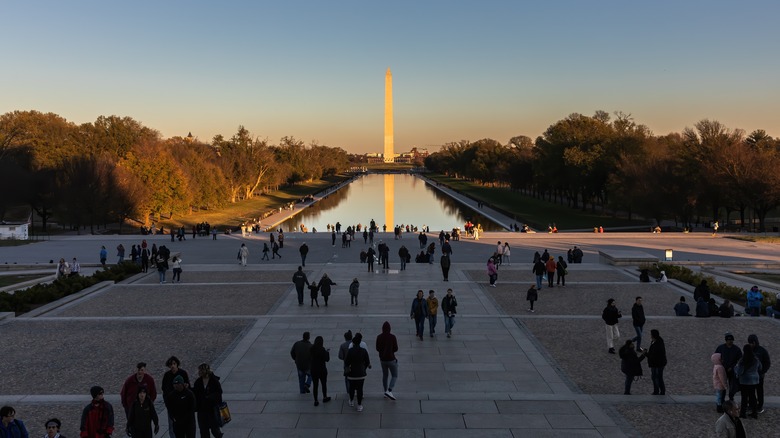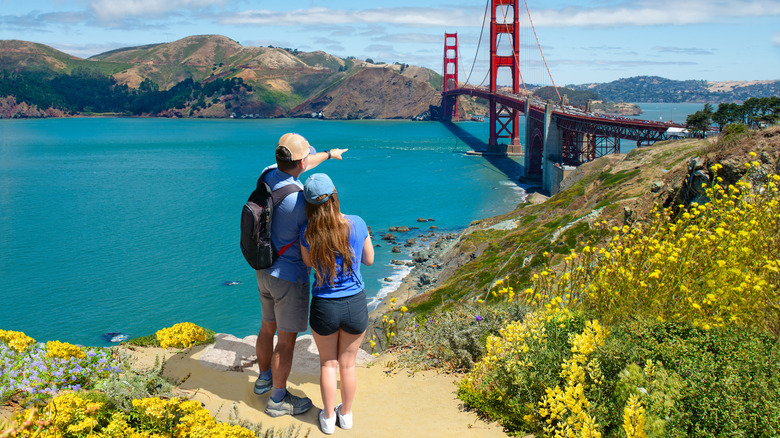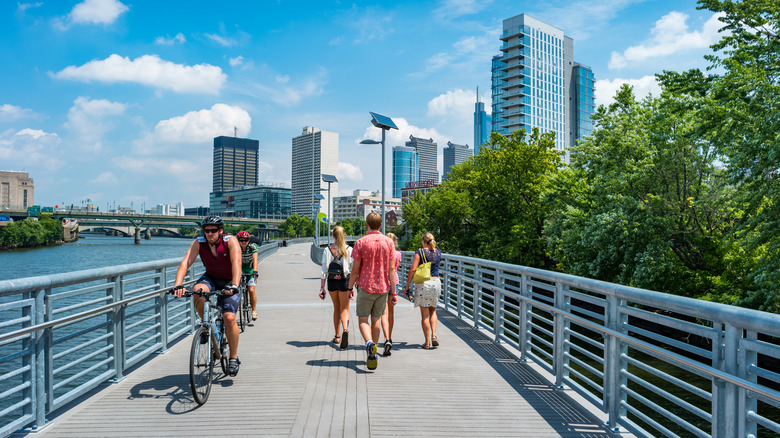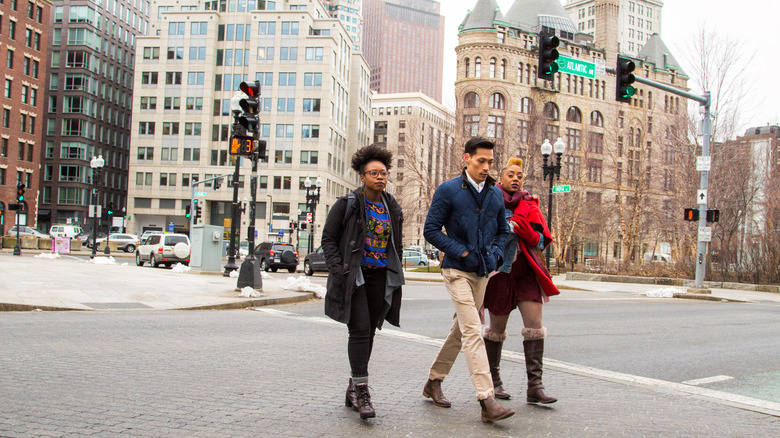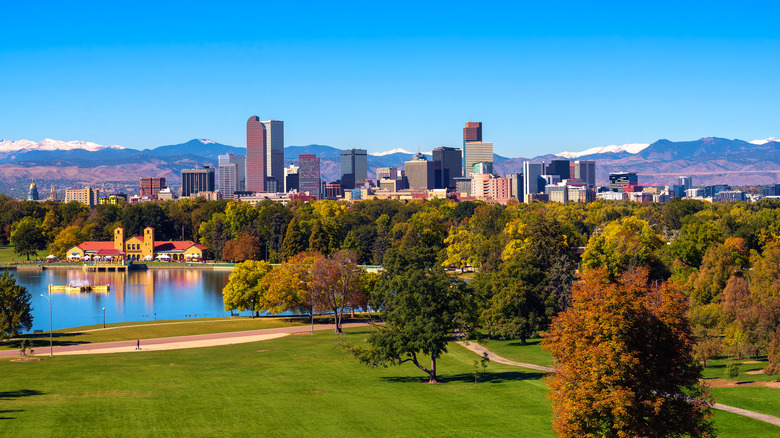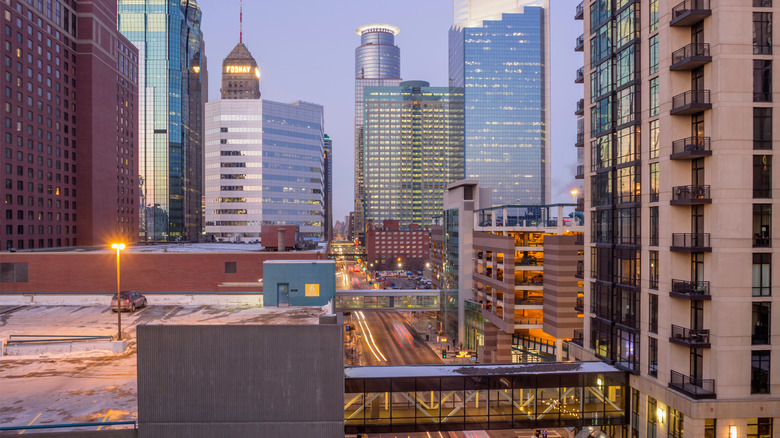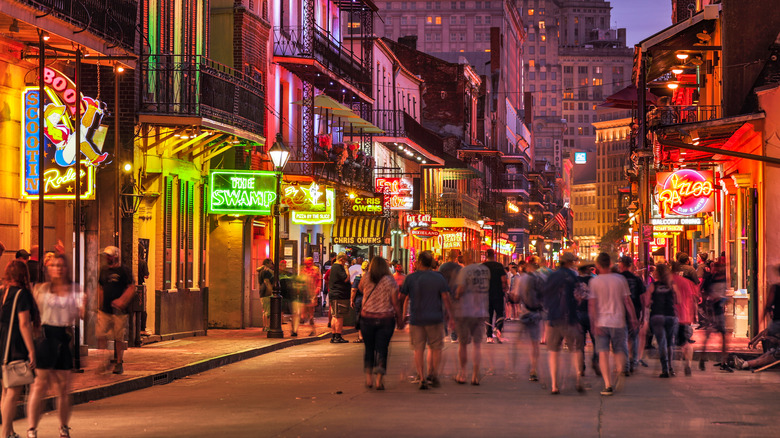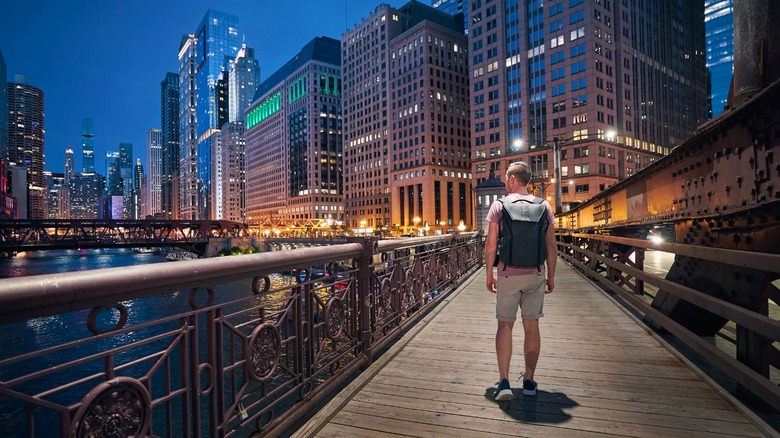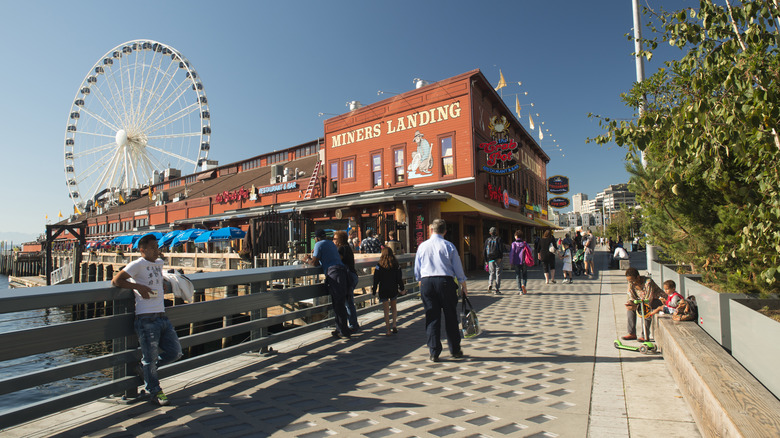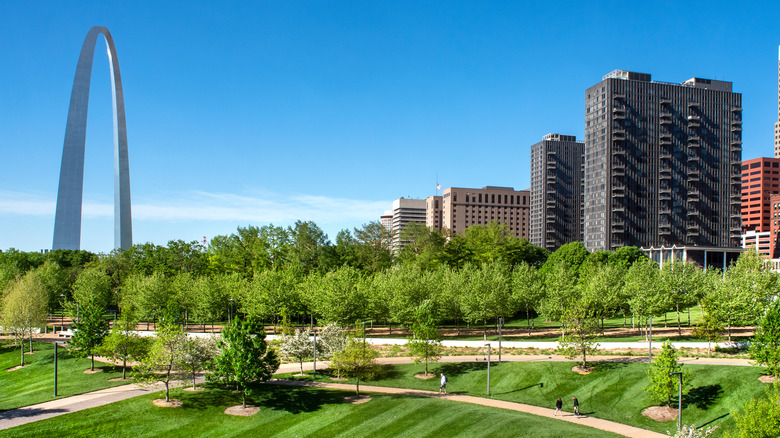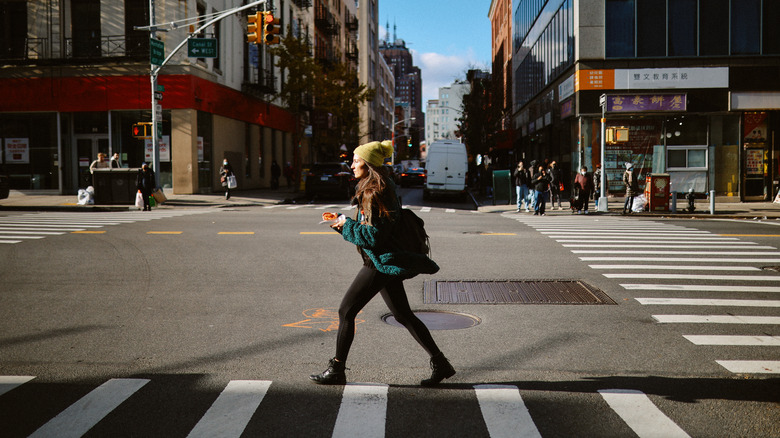The Most Walkable Cities In The US Where You Don't Need A Car
The United States is typically thought of as a car-centric nation, but it doesn't have to be, as there are a number of walkable cities throughout the country. So while the great American road trip might be the main vacation you imagine across the U.S., it isn't the only option.
The rising cost of fuel, congested streets, and still-lingering rental car shortage post-pandemic are all reasons enough to consider a trip sans vehicle. But you don't necessarily need to jet off to Europe to enjoy getting those 10,000-plus steps in. The U.S. is actually full of urban centers where a visit is easily doable without a car. Of course, this is also dependent on where you stay and the neighborhoods you wish to visit. So, in this round-up of 11 cities in the U.S. that are best explored by foot, we've also specified where exactly in each city is pedestrian-friendly, as well as fun parks, urban trails, and other features that make each one a joy to discover by foot.
Washington, D.C.
The nation's capital is one of the most walkable cities in the U.S. and it has a French urban planner named Pierre Charles L'Enfant to thank. President George Washington smartly tapped the young designer (who arrived from France to fight in the Revolutionary War) to draw up a blueprint for the young nation's new capital. And since L'Enfant came from a country where even the smallest towns are built around a central square with foot-friendly streets, it's no surprise that what he envisioned for Washington, D.C. was similar. Instead of a main square for markets though, D.C.'s centerpiece is the National Mall, a two-mile-long stretch from the Potomac River to Capitol Hill.
L'Enfant took the American ideal of "liberty and justice for all" and ran with it in his design for the city. For example, the streets were built wide and with views of the river and other central points, similar to Paris. He also evenly spaced out parks and squares throughout the city along its diagonal grid system that is still in place today. It took over a century before L'Enfant's original plans were implemented, but today the capital city is pleasantly friendly to walkers of all ages.
San Francisco, California
California might be known as the premier destination for a road trip, but if you're sticking to San Francisco, you can skip the car rental and hit the pavement à pied (by foot). The BART system, bus lines, historic streetcars, and electric scooters might be how most visitors expect to navigate San Francisco. However, the city is exceptionally easy to walk, especially in centralized neighborhoods. Downtown San Francisco is a classic example of a pedestrian-friendly core; you definitely won't feel the need for a vehicle while exploring it or close-by areas such as Chinatown, Nob Hill, and North Beach.
Neighborhoods like the Mission and neighboring Hayes Valley are full of quintessential colorful San Francisco buildings, lovingly maintained by residents. Streetcars run up and down the hills, should your feet need a break after climbing the numerous hills of the area. Additionally, Golden Gate Park isn't far away. The Marina District along the water is home to Chestnut Street, a favorite for shopping and cafe-hopping, and often full of dogs. A bit further north is Marina Boulevard which you can follow to the Presidio, a National Historic Landmark District and home to iconic coastal walks with views of the Golden Gate Bridge. You can then follow the water to Sea Cliff, Lands End, and Ocean Beach.
Philadelphia, Pennsylvania
The City of Brotherly Love is often overlooked as a destination by travelers, but if you're looking to get around on foot, it's a fantastic place to visit. In 2023, USA Today voted Philadelphia the most walkable city in America. There are a few reasons why it's so pedestrian-friendly. First, like its cousin to the south, D.C., Philadelphia was designed by an urban planner who prioritized public parks, greenery, and mobility without a car. These ideas are maintained in the present day and residents and tourists alike prefer to enjoy the city on their own two feet. Secondly, thanks to its compact size, the urban center is short and simple to navigate on foot. Only a couple of miles separate the Delaware River and Schuylkill River, which run on either side of the land that houses Philly. So it has a bit of an island feel not unlike Montreal (one of Canada's most pedestrian-friendly cities), although not as pronounced.
Thus the core neighborhoods are seamlessly blended together for an enjoyable place to stroll. You don't feel compartmentalized to the point that you have to take public transport to get from area to area. And since it is such a historic city, there are plenty of sites and points of interest to visit on a nice walk. In fact, walking tours are very popular with visitors, so make sure to take one at some point during your trip!
Boston, Massachusetts
Boston is home to the oldest subway system in the U.S., but the T can be a bit slow, which isn't a problem as it's easy to navigate on your own two feet. Boston is considered one the largest walkable cities in the U.S. This was intentional, as Boston was constructed in the early days of the country when the European influence on the city was still strong. The North End is perfect for walkers who enjoy being near the water. Meanwhile, compact Chinatown is a favorite among visitors, and everything from shops to top-notch dumpling houses are just around the next corner. Beacon Hill is a charming part of the city, full of brick and cobblestone streets that feel like another era. Just be careful on those hills: A casual stroll can quickly turn into a hike and winter can be dangerous.
Additionally, the 3-mile-long Freedom Trail takes you through North End, Beacon Hill, and the Financial District. Pass through numerous points of interest such as the Boston Massacre Site, Boston Common (the oldest public park in the U.S.), Paul Revere House, and the Old South Meeting House, where the Boston Tea Party started. For a nice walk, wander along the Charles River and Boston Public Garden. And don't forget to visit during Cherry Blossom season!
Denver, Colorado
Most often associated with mountains and hiking, Denver is also extremely easy to walk around, as long as you stick to certain areas. Capitol Hill is situated close to downtown and is home not only to the state's capitol building but a large park waiting for you to wander or just relax with a picnic and book. Also located in the neighborhood is a large variety of bars, cafes, and museums including the Molly Brown House Museum, which tells the story of a family's Titanic survival and legacy.
Not far away lies easy-foot-access Five Points, an old historic district that is known for amazing craft breweries, independent coffee shops, and a variety of music venues. It is one of the most compact parts of the city, which makes it extremely easy to navigate on foot. The Highlands area of Denver feels like stepping back in time with all of the old Victorian homes built around central gardens. Additionally, Highlands Square is a public area and truly the heart of social life, similar to a European town. Finally, the Baker area is a short stroll from downtown and ideally located next to the South Platte River that runs through Denver. In recent years the district has grown in both size and popularity but maintained an easy walkability that continues to draw residents and visitors. All of this as well as the light rail expansion is due to intentional design by the city in an effort to increase quality of life.
Minneapolis, Minnesota
The Midwest isn't typically thought of as a pedestrian region, but Minneapolis proves this assumption wrong. The city has undergone a bit of a renaissance in the past decade and is quickly becoming the next big thing for young professionals and families looking for a nice place to live. The Central Business District is an easy part of the city to navigate on foot and is full of fun things to do, despite having "business" in its name. There are many arts venues where you can enjoy some of the top plays, dance performances, and live music. You can also find trendy bars and all the excitement of a big city without the overwhelm. Just bear in mind that it's noisy.
Additionally, the Arts District and River District are fun areas to wander. Both are home to the juxtaposition of old cobbled streets from centuries past, set against newly paved roads and art galleries in former warehouses. However, the most fun you'll likely have navigating Minneapolis is on the Skyway System. These elevated and covered walkways all throughout the city cover nearly 10 miles and connect numerous businesses, restaurants, and shops. It is also the only advisable place to walk for more than a few minutes in winter. Most walkways close on weekends and at 6 p.m. on weekdays, so plan your visit accordingly.
New Orleans, Louisiana
Similar to the Midwest, New Orleans, and the South as a whole aren't very easy to get around without a vehicle. But, if you stick to certain areas, particularly the compact downtown core, you'll be able to walk around. New Orleans might be a typical southern metropolis in many ways, but its French origins show up in numerous ways, including its walkable design. The diverse architecture ranges from Greek-inspired columns to wooden gingerbread-style decor straight out of an alpine town. There are also townhomes with intricate wrought-iron fences, and you'll want to explore it all primarily by foot to get the best views. Most streets are built around public parks and squares, as was typical when the city was founded.
As a visitor, you'll likely stay in the historic French Quarter and adjacent areas, where most points of interest are a short walk from hotels. There is a specified 2-mile stretch of downtown where the majority of accommodations are located, all with close access to restaurants, bars, and cafes, including the famous Cafe du Monde. Once you see New Orleans traffic in person, you'll be relieved to not have to navigate it in a vehicle. And if the Louisiana humidity is getting to you, or you want to venture beyond downtown, there is always the streetcar!
Chicago, Illinois
Chicago is a great destination to stroll around, as long as you visit outside of the famously brutal winter. Many parts of the city are enjoyable to wander on foot and boast lovely views of Lake Michigan. The Loop scores the highest in terms of being easily traversed on foot. This neighborhood is full of green space and close to many restaurants and performance halls as it houses the theater district. It's also where the scenic Riverwalk is located and where you can find river cruises should you want to give your legs a rest for a few hours. Meanwhile, in the Fulton River District, residential homes blend with cute cafes and bars, all within easy walking distance from most homes.
The Grant Park area spans over 300 acres of public land around the downtown core. It's a cultural hub, as many museums call the area home as well as lake trails and sports fields. The neighborhood is a fantastic place to not feel like you're in the city while still being very much within the limits. Finally, the Near North Side is one of the most walkable parts of Chicago, just behind the Loop, and is a great area to spend a day roaming. Take in the change of scenery as this part of the metropolis is set back a bit from the lake and runs along the Chicago River instead.
Seattle, Washington
The Pacific Northwest might be best known for mountains, hiking, and evergreen forests, but the Emerald City has plenty of areas that are great to walk around. The most foot-traffic-friendly neighborhoods close to downtown are Capitol Hill and Queen Anne, with the former being the most popular choice for transplants, especially those from New York, due to its walkability. Cap Hill also has a central light rail station, a streetcar track, and numerous bus lines. Queen Anne is a bit more residential but very easy to walk around, with decent transport connections and cute streets to wander. Both are home to many quintessential old Seattle brick buildings covered with vines and flowers.
A bit further from the downtown core is the U District, popular with students and University of Washington staff and faculty thanks to its proximity to campus and walkability to most amenities. Next door lies Greenlake, named for the lake that is the central point of the neighborhood. Your daily walk can take you on the just-under-3-mile lake loop or around the main streets, full of houses to admire, trendy cafes, and plenty of yoga studios and health stores. And finally, if access to Lake Union is important, try Fremont or South Lake Union, an up-and-coming part of town with techies and transplants. Additionally, Seattle is full of urban walking trails as well.
St. Louis, Missouri
St. Louis' downtown is very pedestrian-friendly thanks to walkways and greenery. The Central West End is home to beautiful historic homes as well as the main universities in town: Washington University and Saint Louis University. Thus you're never far from a great bar, cafe, or park in this neighborhood. Additionally, the downtown core is almost like a mini-Manhattan. Skyscrapers tower over winding footpaths and sidewalks along with numerous green spaces where walkers can have a rest. The ever-expanding bus and light rail systems also run frequently throughout the area.
Additionally, the smaller Lafayette Square is a fantastic neighborhood that will delight walkers of all types. As an older district in St. Louis, the buildings and mansions that make up the area are a feast for the eyes with their multicolored paint jobs and overflowing gardens. And finally, no visit is complete without a stroll along the river to the now Insta-famous Gateway Arch.
New York City, New York
Most urban centers on this list are walkable, but only in certain neighborhoods in and around the downtown core. New York, on the other hand, is known for problematic traffic and inhabitants whose walk could practically outpace many cyclists across the Brooklyn Bridge. Additionally, what makes the city unique is that the walkability is not limited to certain areas: Most of the city is easy to navigate on foot. And, if you're open to a bit of a workout, walking from one neighborhood to the next is absolutely possible. Alternatively, take advantage of the New York City subway system or bus routes between points of departure for your urban walk!
When walking around this metropolis, you can't leave out Central Park or New York City's own elevated park, the High Line. But there are plenty of lesser-known areas that are pleasant to stroll around such as the Hudson River Greenway, the Grand Concourse (the Bronx Champs-Elysées), Governors Island, and Astoria Park. Another feature that sets NYC apart from other cities is that not only can you navigate it without a vehicle, but getaways from the city are doable sans car. The northeastern Amtrak corridor is one of the best in the U.S.; just hop on a train, and within a few hours you can be in scenic Upstate, New Jersey, or even Canada.

